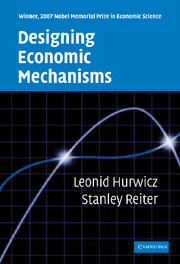2 - From Goals to Means: Constructing Mechanisms
Published online by Cambridge University Press: 24 May 2010
Summary
Introduction
Our objective in this chapter is to provide a somewhat informal description of systematic procedures for constructing informationally efficient decentralized mechanisms that realize a given goal function.
A goal function represents outcomes or actions deemed desirable in each possible environment under consideration. An environment is specified by the values of finitely many parameters that together form the parameter space. Their values define feasibility of allocations and preferences of the agents. A goal function has as its domain a factored parameter space (in this chapter usually Euclidean or finite), and a Euclidean or finite outcome space as its range.
A mechanism is a triple consisting of (i) a message space, (ii) a system of decentralized equilibrium relations (correspondences, equations), and (iii) the outcome function that translates equilibrium messages into outcome choices. A mechanism models communication through messages, their verification by agents, and the outcomes associated with equilibrium messages.
DEFINITION. We say that a mechanism realizes the goal function if
(i) (existence) for every parameter point θ, there exists a corresponding equilibrium point m in the message space.
(ii) (optimality) if m is an equilibrium message for θ, then the outcome z specified for m by the outcome function is desirable according to the goal function – F-optimal.
- Type
- Chapter
- Information
- Designing Economic Mechanisms , pp. 63 - 181Publisher: Cambridge University PressPrint publication year: 2006



